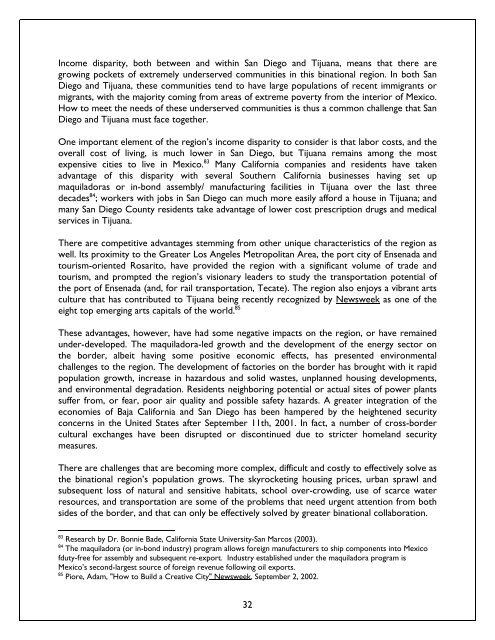Blurred Borders - International Community Foundation
Blurred Borders - International Community Foundation
Blurred Borders - International Community Foundation
Create successful ePaper yourself
Turn your PDF publications into a flip-book with our unique Google optimized e-Paper software.
Income disparity, both between and within San Diego and Tijuana, means that there are<br />
growing pockets of extremely underserved communities in this binational region. In both San<br />
Diego and Tijuana, these communities tend to have large populations of recent immigrants or<br />
migrants, with the majority coming from areas of extreme poverty from the interior of Mexico.<br />
How to meet the needs of these underserved communities is thus a common challenge that San<br />
Diego and Tijuana must face together.<br />
One important element of the region’s income disparity to consider is that labor costs, and the<br />
overall cost of living, is much lower in San Diego, but Tijuana remains among the most<br />
expensive cities to live in Mexico. 83 Many California companies and residents have taken<br />
advantage of this disparity with several Southern California businesses having set up<br />
maquiladoras or in-bond assembly/ manufacturing facilities in Tijuana over the last three<br />
decades 84 ; workers with jobs in San Diego can much more easily afford a house in Tijuana; and<br />
many San Diego County residents take advantage of lower cost prescription drugs and medical<br />
services in Tijuana.<br />
There are competitive advantages stemming from other unique characteristics of the region as<br />
well. Its proximity to the Greater Los Angeles Metropolitan Area, the port city of Ensenada and<br />
tourism-oriented Rosarito, have provided the region with a significant volume of trade and<br />
tourism, and prompted the region’s visionary leaders to study the transportation potential of<br />
the port of Ensenada (and, for rail transportation, Tecate). The region also enjoys a vibrant arts<br />
culture that has contributed to Tijuana being recently recognized by Newsweek as one of the<br />
eight top emerging arts capitals of the world. 85<br />
These advantages, however, have had some negative impacts on the region, or have remained<br />
under-developed. The maquiladora-led growth and the development of the energy sector on<br />
the border, albeit having some positive economic effects, has presented environmental<br />
challenges to the region. The development of factories on the border has brought with it rapid<br />
population growth, increase in hazardous and solid wastes, unplanned housing developments,<br />
and environmental degradation. Residents neighboring potential or actual sites of power plants<br />
suffer from, or fear, poor air quality and possible safety hazards. A greater integration of the<br />
economies of Baja California and San Diego has been hampered by the heightened security<br />
concerns in the United States after September 11th, 2001. In fact, a number of cross-border<br />
cultural exchanges have been disrupted or discontinued due to stricter homeland security<br />
measures.<br />
There are challenges that are becoming more complex, difficult and costly to effectively solve as<br />
the binational region’s population grows. The skyrocketing housing prices, urban sprawl and<br />
subsequent loss of natural and sensitive habitats, school over-crowding, use of scarce water<br />
resources, and transportation are some of the problems that need urgent attention from both<br />
sides of the border, and that can only be effectively solved by greater binational collaboration.<br />
83 Research by Dr. Bonnie Bade, California State University-San Marcos (2003).<br />
84 The maquiladora (or in-bond industry) program allows foreign manufacturers to ship components into Mexico<br />
fduty-free for assembly and subsequent re-export. Industry established under the maquiladora program is<br />
Mexico’s second-largest source of foreign revenue following oil exports.<br />
85 Piore, Adam, "How to Build a Creative City" Newsweek, September 2, 2002.<br />
32















